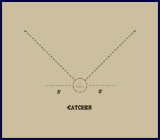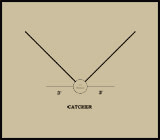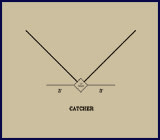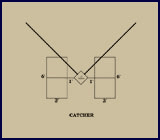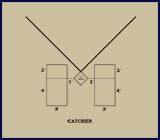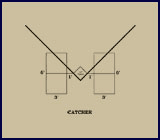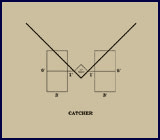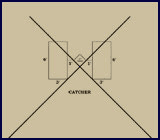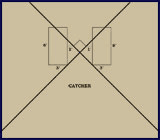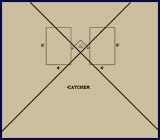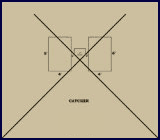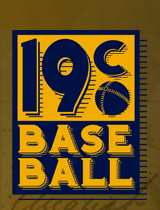Evolution of the Batter's Area
By Eric Miklich
rom 1845 through 1867 Home Base was circular, made of iron, painted or enameled white and 12 inches in diameter.
From 1845 through1876, a batted ball was determined fair of foul depending on where the ball first made contact with the ground. If a batted ball hit first in fair territory, the ball was fair even if it immediately moved to foul territory. If a batted ball first hit in foul territory, the umpire was required to declare a foul ball.
In 1877, a batted ball was required to remain in fair territory until passing either first or third base, in which case the ball was allowed to move into foul territory and still be considered fair.
From 1845 through 1874, if a batted ball struck Home Base, the umpire was tasked to decide if the ball hit the part of Home Base that was in fair territory or the part that was in foul territory. If the ball hit the portion of Home Base in foul territory he was required to announce loudly that the ball was foul. In 1875 and 1876, Home Base was moved entirely in to foul ground, making the umpires decisions an easy one. Home Base was moved entirely into fair ground for the 1877 season.
In 1857, Home Base was centered on one of the four corners of the 30 yard square "infield." The batter's line was six feet in length and was through the center of Home Base, three feet either side of the base. This line was not specified to be marked on the playing field by chalk and it was most likely maintained by the umpire during the game. The striker was free to start any where behind the line and was allowed to move forward as the ball was pitched. When striking at the ball all the batsman was required to do was to stand back of the six foot line crossing Home Base.
After the first base ball convention, in 1858, the rule was changed so that the batters movements were restricted and they were now mandated to start with one foot on the 3' batter's line prior to the ball being delivered to the Home Base. The umpires were also empowered to warn the striker and then begin calling strikes if he refused to swing at "good balls." After a warning and three called strikes the batter was required to attempt to "make his first" if the ball was not caught on the fly or the first bound by the catcher.
Beginning in 1861, the rules required that that Foul Ball Lines be marked on the playing field. They each began from the center of Home Base and ended at the 90' mark at first and third base. This aided umpires in determining fair or foul batted balls striking the ground near Home Base.
The pitcher was held accountable for unfair pitched balls in 1863, and the umpire was instructed to call these balls after warning the pitcher. After warning the Pitcher and calling three "unfair" balls, the batter was entitled to first base and any runner occupying a base also advanced one base whether forced or not.
Home Base was changed to a 12 inch square flat plate in 1868, was still required to be painted white and the center of the newly shaped base was also placed on the intersection of the third and first base line. One corner faced the Pitcher, the "Pitcher' Point" and the opposite corner faced the catcher and was called the "Catcher's Point."
Two rule changes occurred in 1869. A foul strike would be called if the batter stepped backward while in the act of striking and when three foul strikes were called the batter was out. If the batter received his base on called balls only the base runners that were forced to do so also moved one base.
The Batter's Lines were required to be marked by chalk for the first time beginning in 1870. Prior to this it was the responsibility of the umpire to maintain the line during the match. Also beginning in 1870, the umpire was instructed not to call the first ball delivered to the batters during the match.
With the Start of the first professional baseball league in the United States, The National Association of Professional Base Ball Players, the batter was given a large advantage for the 1871 season. He was allowed to call for a "high" or "low" ball. A "low pitch" was a ball delivered by the pitcher that was between the striker's knees and his waist and passed over Home Base. A "high pitch" was a ball delivered by the pitcher that was between the striker's waist and his shoulders and passed over Home Base. The striker was also allowed to step forward in the act of striking as long as he was still astride the three foot line and was not to stand closer than one foot to Home Base.
In 1872, the second season of the National Association, Home Base was required to be made of white marble or stone and placed even with the ground.
The "Batter's Box" was first instituted in 1874. It was six feet long and centered to the middle of Home Base. It was one foot from Home Base and three feet wide over all and required to be marked with chalk. The batter was required to be within the lines of his position during the act of striking and if contact was made and the batsman was outside the lines of the box, a foul strike and out was called and the ball was considered dead. Three foul strikes during a Batsman's time at bat put him out.
Home Base was moved entirely into foul ground in 1875 as was the Batter's Box. Only two feet of the batters box extended forward, toward the pitcher, from the center of Home Base and four feet extended toward the catcher. The umpire was now allowed to call the first ball delivered by the pitcher.
After the NA ceased operations at the close of the 1875 season and the National League of Professional Base Ball Clubs began play in 1876. The batter also was given three minutes to appear in the box after a striker was called for by the umpire.
Home Base was moved entirely into fair ground in 1877 and would remain in fair ground for the rest of the 19th century. Home base was allowed to be wood, iron or stone that was whitened. The batter's box was now centered to the middle of Home Base and three feet extended to towards the pitcher's box and three feet extended towards the catcher. The striker was now only given one minute to take his position once called for by the umpire.
Home Base was to be comprised only of white marble or stone starting with the 1878 season.
When the American Association of Base Ball Clubs began play in 1882, they followed the same rules for the size, composition (white marble or white stone) and placement of Home Base and the same size and placement of the batter's box.
The Union Association followed the same specifications for the batter's box, the placement and the composition of Home Base for their only season in 1884.
In the National League in 1885 Home Base was to be made out of white rubber or stone. The batter's box was moved to six inches from Home Base and its size was increased to six feet long by four feet wide. The American Association changed the composition of Home Base to only white rubber but the batter's box remained three feet wide and six feet long, one foot from Home Base.
The American Association, in 1886, allowed Home Base to be made of white stone, iron or rubber and followed the NL's dimensions and placement of the batter's box, six feet long by four feet wide, six inches from the center of Home Base.
When the National League and American Association followed the same rules in 1887 it was stated that Home Base was to be made out of whitened rubber only. The batter was no longer allowed to call for a high or low pitch and a fair ball was one that passed over some part of Home Base and was between the batter's knees and his shoulders.
The Players' National League of Base Ball Clubs also followed the same batter's box dimensions and placement and Home Base composition for their only season in 1890.
The American Association halted operations at the end of 1891 and four of its teams joined the National Leagues for the 1892 season and became the National League and American Association of Base Ball Clubs. The league would return to being solely named the National League of Base Ball Clubs in 1899.
In the National League in 1900, Home plate is converted to the present day pentagonal shape, 17-inches wide.
